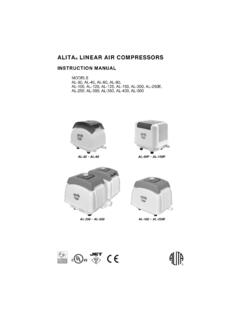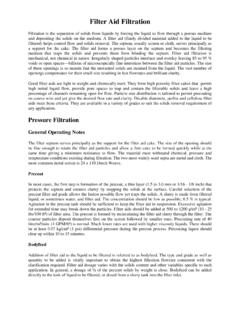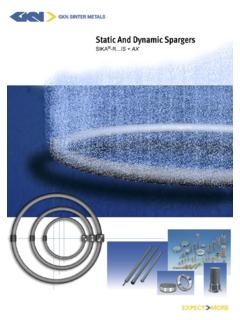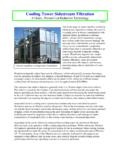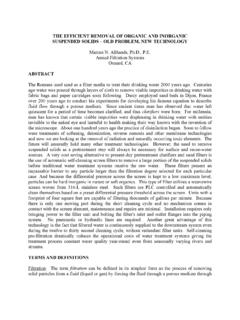Transcription of Porous High Density Polyethylene Tubes - ALITA Industries
1 Porous high Density Polyethylene Tubes high Density Polyethylene (HDPE) Porous Tube is a durable solution for fine pore diffusion of air and other gases. Each tube is designed to fit standard Schedule 40 PVC end fittings and couplings. The omni-directional Porous structure is excellent for diffusing, sparging, and aeration applications, emitting a multitude of small, evenly distributed bubbles. Applications: Municipal and industrial wastewater treatment. Aquaculture aeration (growout ponds, hauling trucks, etc.). Air agitation of electroplating solutions baths. Fermentor sparging for food, beverage, and pharmaceutical Industries . Desiccant containers Air agitation in food processing Foaming of cleaning solutions Features and Benefits: Rigid, lightweight Schedule 40 sized Tubes are easy to handle and can be easily fabricated into piping systems with off the shelf components. high - Density Polyethylene Tubes have excellent resistance to chemicals and abrasion.
2 Omni-directional Porous structure, available in fine, medium, and coarse pore sizes, provides uniform distribution of fine bubbles. Material complies with the Code of Federal Regulations (USA), Title 21, Section 520 Item , for food contact. MODEL TUBE SIZE TUBE TUBE LENGTH MATERIAL AVERAGE PORE SIZE. HPT-050 1/2" Schedule 40 " / " " / " 48" HDPE 20 40 m HPT-075 3/4" Schedule 40 " / " " / " 48" HDPE 20 40 m HPT-100 1" Schedule 40 " / " " / " 48" HDPE 20 40 m HPT-200 2" Schedule 40 " / " " / " 48" HDPE 20 40 m HPT-D50 1/2" 1/2" 1/4" 36" UHMW-PE 20 m HPT-D75 3/4" 3/4" 1/2" 36" UHMW-PE 20 m ALITA Industries , Inc. Ph: 626-962-2116 Fax: 626-962-2177. Porous high Density Polyethylene Tubes Fabrication Techniques: Cutting, Turning, and Drilling Conventional band, table, and hand saws may be utilized as well as lathes and drills. Thread Cutting External or internal threads can be cut using standard metal cutting tools, either on a lathe or by hand.
3 A stronger thread can be achieved by dipping the area to be threaded into PVC pipe cement and allowing it to harden before cutting the threads. Bonding and Sealing Tubes can be bonded to fittings and couplings using hot melt adhesives, PVC plastic pipe cement, epoxy, or similar sealants. These adhesives form a strong mechanical bond by curing on the surface and within the pore structure of the tube. Characteristic of HDPE Porous Plastic Throughout all HDPE Porous plastic runs an intricate network of open-celled, onmi-directional pores. These pores, which can be made in average pore sizes down to one micron, give Porous plastics their unique combination of filtering capability and structural strength. Unlike the direct passages in woven synthetic materials and metal screens, the pores in Porous plastic join to form many tortuous paths giving Porous plastics a dual filtering capability. Not only do they act as surface filters by trapping particles large than their average pore size, they also trap much smaller particulate matter deep in their complex channels for a "depth filter" effect.
4 This tortuous path structure is so efficient that, as a rule of thumb, with an average pore size of 25 microns, offer you approximately the same filtration as many five micron-rated filters. HDPE can be used in continuous service at temperatures up to 180 F (82 C) and intermittently at 240 F. (116 C). If not stressed, it is stable at 212 F (100 C) in continuous service. HDPE Porous Plastics are naturally hydrophobic, but aqueous solutions can be forced through under pressure. The material is cleanable with HCI (muriatic acid) or chlorine. Not recommended in presence of strong oxidizing acids, prolonged fire and sunlight and solvents above 176 F. (80 C). ALITA Industries , Inc. Ph: 626-962-2116 Fax: 626-962-2177. RATING SYSTEM CHART. The following codes are used to rate chemical resistance of the Porous high Density Polyethylene (HDPE) Tubes with various substances. G = Good F = Fair P = Poor N = Not Recommended (some swelling or degradation will probably occur).
5 HDPE HDPE. SUBSTANCE AT 21 C (70 F) UHMW PE SUBSTANCE AT 21 C (70 F) UHMW PE. Acetaldehyde G Clophen A50 and A6 G. Acetic acid, 10% G Coconut oil G. Acetic Acid, 100% (Glacial) G Common salt (Aqueous, saturated) G. Acetic anhydride G Copper salts G. Acetone G Corn oil G. Acide, aromatic G Creosote G. Acrylonitrile G Cresol G. Aallyl alcohol, 96% G Cyclohexane G. Aluminum Chloride G Cyclohexanol G. Alum G Cyclohexnone G. Amonia G Dibutyl ether F. Ammonia, gaseous G Dibutyl phthalate G. Ammonium salts G Dichloracetic acid, 50% G. Amyl acetate G Dichloracetic acid, 100% G. Anisole F Dichloracetic acid methyl ester G. Antimony trichloride G Dichlorobenzene-o F. Aqua regia N Dichlorobenzene-p F. Beer G Dichloroethylene N. Beeswax G Diesel oil G. Benzaldehyde G Diethyl ether F. Benzene F Diisobutyl ketone G. Bensenesulphonic acid G Dimethylamine G. Benzoic acid G Dimethyl formamide G. Benzol Chloride F Dimethyl sulphoxide G. Borax G Dioxane G. Boric acid G Emulsifiers G.
6 Brine (saturated) G Epichlorhydrin G. Bromine (liquid) N Esters, aliphatic G. Bromochloromethane N Ethanol 96% G. Butanol G Ether F. Butylacetate G Ethyl acetate G. Butylene glycol G Ethylene chloride (Dichloroethane) F. Butyric acid G Ethylenediaminetetraacetic acid G. Calcium chloride G Ethylene gylcol G. Calcium hupochlorite G Fatty acids (C) G. Calcium nitrate, 50% G Ferric chloride G. Camphor G Fluorine N. Carbon disulphide F Fluosilicic acid G. Carbon tetrachloride P Formaldehyde (40% aqueous) G. Carbonic acid G Formic acid G. Castol oil G Frigenr F. Caustic potash G Fruit juices G. Caustic soda G Fruit pulp G. Chloral hydrate G Fuel oil G. Chlorine (liquid) N Furfuryl alcohol G. Chlorine gas (dry) F Gelatine G. Chlorine gas (wet) F Glycerine G. Chloloracetic acid (mono) G Glycol (concentrated) G. Chlorobenzene F Glycolic acid, 55% G. Chlorethanol G Glycolic acid, 70% G. Chloroform P Glycolic acid butyl ester G. Chlorosulphonic acid N Hylothane F.
7 Chromic acid, 80% G Hydraulic fluid G. Citric acid G Hydrazine hydrate G. HDPE HDPE. SUBSTANCE AT 21 C (70 F) UHMW PE SUBSTANCE AT 21 C (70 F) UHMW PE. Hydrobromic acid, 50% G Polyglycois G. Hydrochloloric acid, all conc. G Potassium bichromate, 40% G. Hydrochloric acid gas (dry and wet) G Potassium chloride G. Hydrocyanic acid G Potassium cyanide (aqueous, saturated) G. Hydrofluoric acid, 40% G Potassium hydroxide (30% aqueous) G. Hydrofluoric acid, 70% G Potassium nitrate (aqueous, saturated) G. Hydrogen peroxide, 30% G Potassium permanganate G. Hydrogen peroxide, 90% G Propionic acid, 50% G. Hydrogene sulphide G Propionic acid, 100% G. Hydrosulphine (10%, aqueous) G Propylene glycol G. Iodine tinture, DAB 6 (German Phamacopoeia) G Pseudocumene G. Isoocatane G Pyridine G. Isopropanol G Sea water F. Isopropyl ether F Silicic acid G. Ketones G Silicone oil G. Lantic acid G Silver nitrate G. Linseed oil G Sodium benzoate G. Liquid paraffin G Sodium borate G.
8 Magnesium chloride G Sodium carbonate G. Maleic acid G Sodium chloride G. Malic acid, 50% G Sodium chloride, 50% G. Menthol G Sodium chloride bleach F. Mercury G Dodium dodecylbenzene-Sulponate G. Mercuric Chlorine (corrosive sublimate) G Sodium hydroxide-30% aqueous G. Methanol G Sodium hypochlorite, all concs. G. Methoxybutanol G Sodium nitrate G. Methoxybutylacetate G Sodium peroxide, 10% G. Methylcyclohexane F Sodium peroxide, 10% saturated F. Methylene chlorine F Sodium sulphide G. Methyl ethyl ketone G Sodium thiosulphate G. Methyl glycol G Spermaceti G. Monochloracetic acid G Spindle oil F. Monochloracetic acid ethyl ester G Starch G. Monochloracetic acid methyl ester G Stearic acid G. Morpholine G Succinic acid, 50% G. Motor oil (HD oil) G Sugar syrup G. Nephtha G Sulphates G. Naphthalene G Sulphur G. Nickel salts G Sulphur dioxide (dry) G. Nitric acid, 25% G Sulphur dioxide (wet) G. Nitric acid, 50% F Sulphuric acid, 10% G. Nitrobenzene G Sulphuric acid, 50% G.
9 Nitotoluene G Sulphuric acid, 98% F. Nitrous gases G Sulphurous acid G. Oils (ethereal) F Sulphuryl chloride N. Oils (vegetable and animal) G Synthetic detergents G. Oleic acid, conc. G Tallow G. Oleum N Tannic acid, 10% G. Oxalic acid, 50% G Tartaric acid G. Ozone F Tetrabromoethane P. Perchloric acid, 20% G Tetrachloroethane P. Perchloric acid, 50% G Tetrahydrofuran P. Perchloric acid, 70% G Toluene P. Petrol G Transformer oil G. Petro/Benzene mixture G Tributyl phosphate G. Petroleum G Trichloraecetic acid, 50% G. Petroleum ether G Trichloroacetic acid, 100% G. Phenol G Trichloroethylene P. Phosphates G Tricresyl phosphate G. Phosphoric acid, 25% G Triethanolamine G. Phosphoric acid, 50% G Turpentine oil F. Phosphoric acid, 95% G Urea, 33% G. Phosphorus oxychloride G Vaseliner F. Phosphorus pentoxide G White spirit F. Phosphorus trichloride G P-Xylene F. Photographic developers G Yeast F. Phthalic acid, 50% G Zinc Chloride G.
